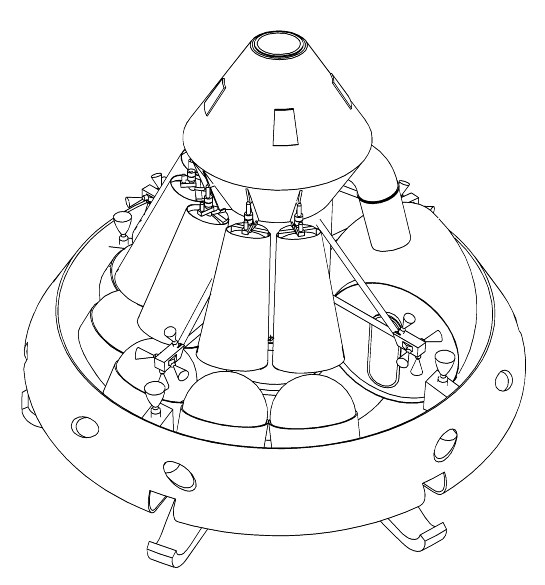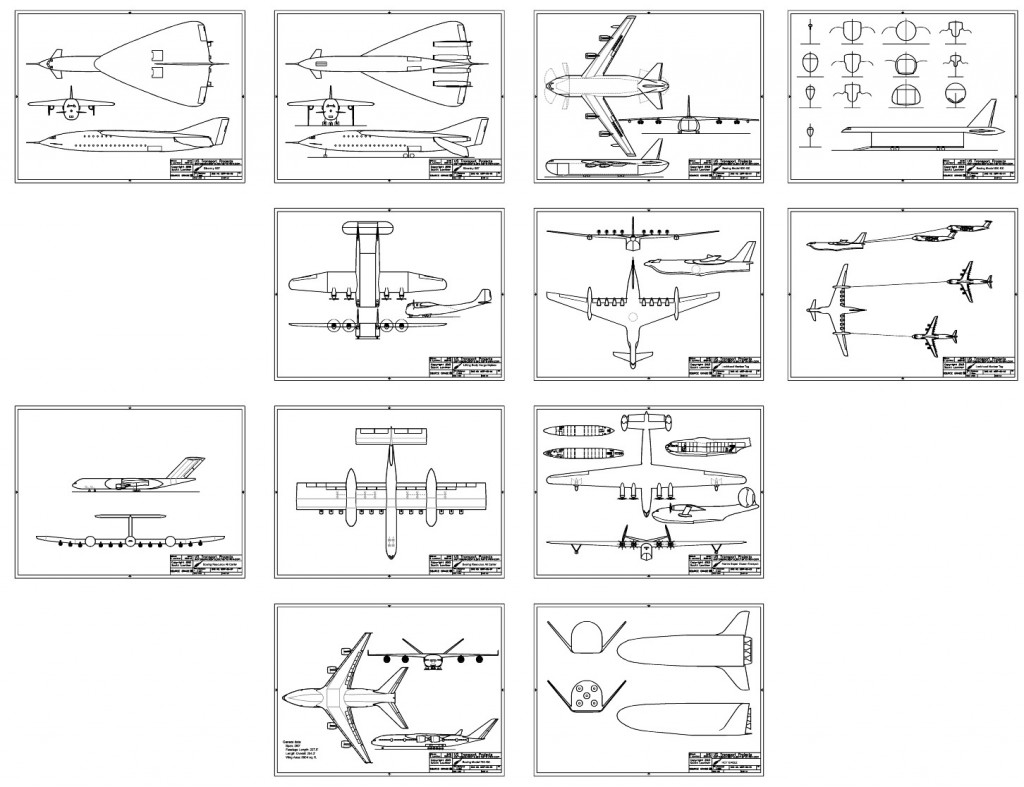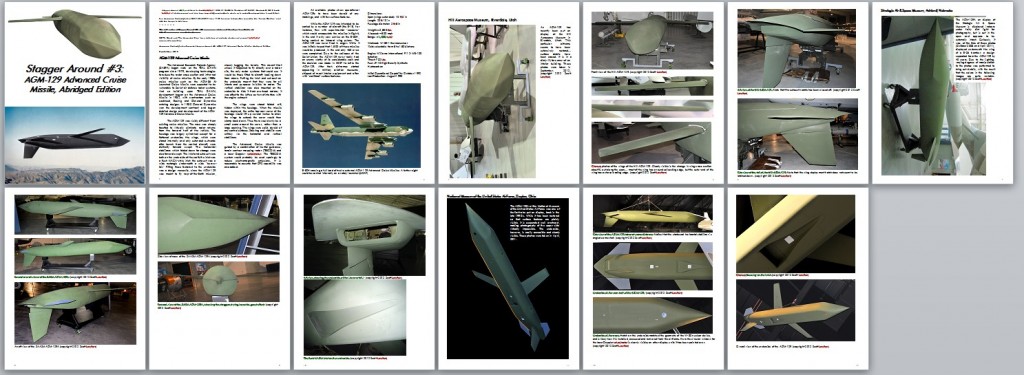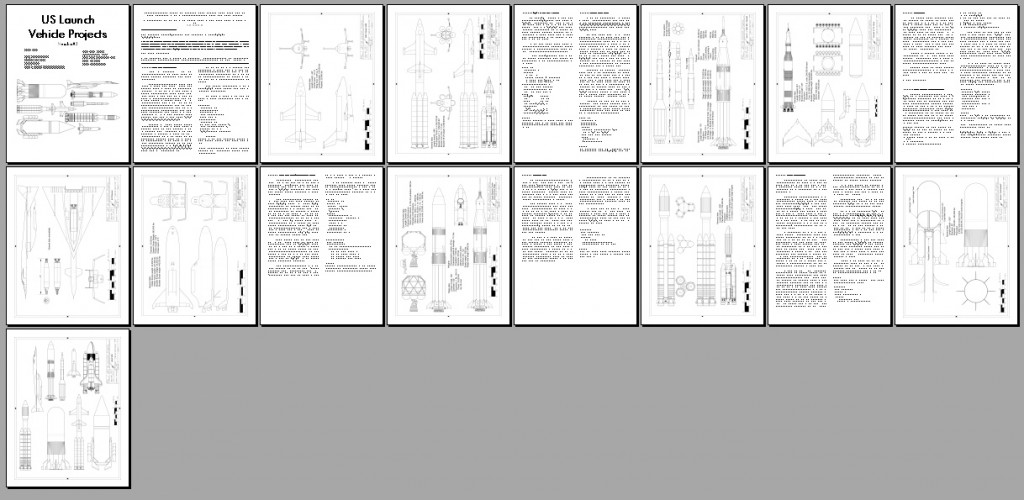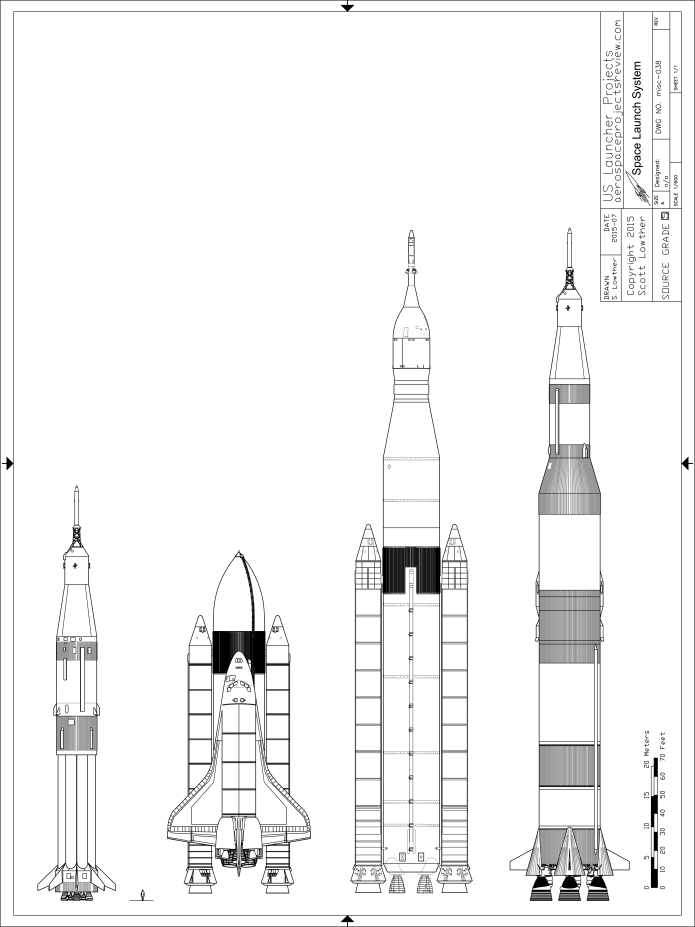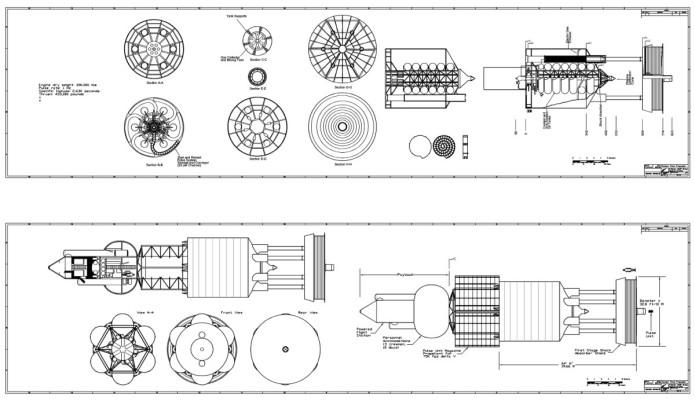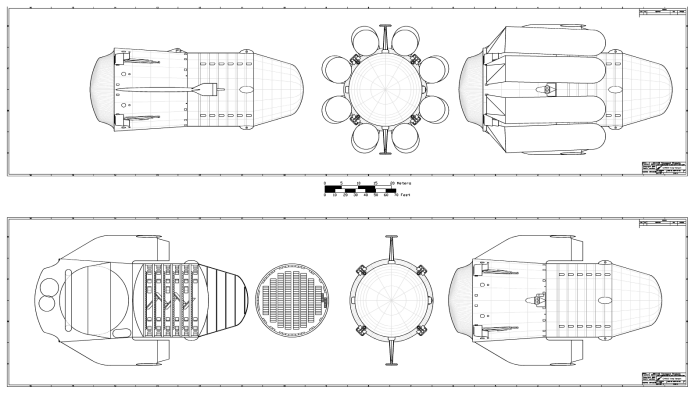The next issue of US Space Projects will, like the previous issue, include diagrams created via 3D modelling. This time it’ll be for the North American Aviation Mars Excursion Module.
I’ve finally received a copy of The 2001 File: Harry Lange and the Design of the Landmark Science Fiction Film which covers the work done by designer Harry Lange on “2001: A Space Odyssey.” Included within it is a *mass* of preliminary sketches and he like… and one “Space Station-5 Final Design Blueprint.” The model is shown as being 8 feet in diameter.
The scale of the model is given as 1/32″ = 1’0″ which, if I’ve done my math correctly equates to 1/384 scale. Und zo… overall diameter of Space Station 5 is 8*384 feet… 3,072 feet.
UPDATE, two years later: Welp, turns out I made a stupid mistake. The 1/384 scale is correct… but for the *drawing,* not the *model.* The Drawing was reproduced at 1/4 the full scale of the model, so the diameter of the full-scale space Station V would be 1/4 X 3,072 feet = 768 feet, much more in line with understanding and logic.
Around about a year ago I got some vague rumors that one of the forthcoming books would have a reliable blueprint of the Station; awaiting this was one of the reasons why my work on my Space Station V diagrams ground to a halt. I figured the diagrams would show the station to be smaller than I had estimated. I did not expect that it would be *way* bigger. Well, there it is. When the facts don’t match your cherished theory… change the theory to match the facts.
The diagram is a close match for the model as built; it’s not some really early concept (though there are lots of those). So it is as close to “canon” as you can get.
As for the book: this is one of those books us “2001” engineering nerds have been waiting for. it doesn’t commit the dreadful sin of trying the force the pages into some weird shape or size; the pages are about 10″ by 11.” It’s more than 300 pages, *filled* with sketches and art and diagrams, including many of the Orion III, the Station, Discovery, Moon bus, etc. Layout map of Clavius Base, satellite designs, secondary vehicles, the works. If you haven’t ordered a copy, do so. It’s worth the price.
The 2001 File: Harry Lange and the Design of the Landmark Science Fiction Film
—
OK, so I wrote about the “Have Sting” orbital railgun, and produced some provisional diagrams of it, publishing them in US Space Projects #3. A blog article was written for War Is Boring discussing “Have Sting,” based in no small part on my diagrams. OK, so far so good. But then other blogs start writing about Have Sting, and an error is introduced.
Whenever a blog post links to my blog, a “pingback notification” is sent to my blog dashboard. I’ve just glanced at these, haven’t given them much thought. For the most part they seem to be just parroting the verbiage from the War is Boring piece. But with one change: “Have Sting” has become “Have Sling.” A “T” became an “L.”
Examples:
http://www.extremetech.com/extreme/219718-exploring-the-death-star-space-gun-america-never-built
In September, the Aerospace Project Reviews Blog published some fascinating diagrams depicting “Have Sling,” which aerospace historian Scott Lowther described as “[a] General Electric design for a gigantic orbital railgun.” Have Sling was never built, of course.
http://www.usaspeaks.com/news/exploring-the-death-star-space-gun-america-never-built/
September, the Aerospace Project Reviews Blog published some fascinating diagrams depicting “Have Sling,” which aerospace historian Scott Lowther described as “[a] General …
http://www.usaspeaks.com/news/exploring-the-death-star-space-gun-america-never-built/
http://www.viralnewstrend.com/exploring-the-death-star-space-gun-america-never-built/
And a bunch more, all seemingly the same post over and over.
And if you Google “have sling” and some other terms, some seriously wacky stuff appears, which I’m guessing is the result of some weird auto-translation:
http://www.bbtechnonews.com/index.php/2015/12/19/exploring-the-death-star-space-gun-america-never-built/
In September, the Aerospace Task Reviews Blog site released some remarkable layouts portraying “Have Sling,” which aerospace chronicler Scott Lowther
“Aerospace Task Reviews?”
And:
http://journalfocus.com/2015/12/exploring-the-death-star-space-gun-america-never-built/
Exploring the ‘Fatality Celebrity’ space gun America never built
UNITED STATE protection coordinators did at one time think about constructing a huge Fatality Star-like gun in space as component of the “Celebrity Wars” rocket protection program, as Warisboring’s Steve Weintz advised us this week in the middle of the hullaballoo of the position of The Pressure Awakens.
In September, the Aerospace Job Reviews Blog site released some interesting representations portraying “Have Sling,” which aerospace chronicler Scott Lowther…
… the styles explain a space tool the dimension of the International Space Terminal, each Lowther.
Buh?
So now when people try to research orbital railguns, there’s every chance that they will be presented with the fallacious designation “Have Sling.”
I just did a Google search on “railgun” and “Have Sling.” It spat back 741 results. “Railgun” and “Have Sting” only produced 321 results. The lie traveled around the world while the truth was still putting on its boots. And entertainingly, in doing some Googling for this post, I found this blog post. It is illustrated in part by “Do NOT try this at home: schematics for the orbital railgun . (Image courtesy up-ship.com.)” I found this illustration amusing for two reasons… firstly, when you say “Image courtesy whoever,” generally you’ve asked whoever for permission to republish. I usually don’t mind people reposting the images I create, but I wasn’t asked here, just sayin.’ More entertainingly, the diagrams of the “orbital railgun” are in fact my diagrams for the 10-meter USAF Orion. Which ain’t a railgun.
It has been a while since I’ve put out a Pax Orionis story, but a new one has just been made available to the Pax Orionis Patreon patrons. This one tells of the maiden voyage of the Columbia and the resulting changes in geopolitics…
The bonus version (available to $2 & up patrons) includes diagrams and data on the Nova-class lofter as well as a bonus news article. If interested, check out the Pax Orionis Patreon. It’s cheap!
For those unaware: Pax Orionis is an alternate history project. In short, the Cuban Missile Crisis goes a little “funny,” resulting in the US fielding nuclear pulse propelled spacecraft (Orions). The goal is hard SF covering a number of decades of events, good, bad and really quite awful.
I was reminded of the AGM-129 Advance Cruise Missile today, which reminded me of the small heavily illustrated booklet on the AGM-129 I put together a few years ago. It’s probably not too late to buy a couple hundred of these as Christmas presents for your friends and family. Here’s a retread of the original post from Back Then:
– – – – – –
Literally years in the making, I’ve put together two versions of a photo essay of several surviving examples of the AGM-129 Advanced Cruise Missile. Available free for the downloading is Stagger Around #3: AGM-129 Advanced Cruise Missile, Abridged Edition as a 13 page PDF booklet. This contains photos of the AGM-129s on display at Hill Aerospace Museum in Utah, the USAF Museum in Dayton and the Strategic Air & Space Museum in Nebraska, ready to print.
Also available is Stagger Around #3: AGM-129 Advanced Cruise Missile, Full Edition. This 34-page edition includes more photos of these missiles, along with the missile at the San Diego Aerospace Museum restoration facility, a rare General Dynamics display model, official USAF photos of the AGM-129 in test and in service and drawings of the missile, including 1/32 scale layout diagrams. This is available through MagCloud, either as a downloadable PDF ($5.75) or as a professionally printed and bound edition ($11.80).
Don’t forget to check out my other MagCloud publications, including Justo Miranda’s Reichdreams Dossiers, Aerospace Projects Review, Historical Documents, and Photographing Stuff.
And don’t forget to check out Stagger Around #1, F-104A Starfighter, and Stagger Around #2, Starship Enterprise.
NOTE:
If you liked this and want to see more like it… feel free to toss fifty cents, a buck, a hundred bucks, whatever, my way. Think of it as a donation to a worthy cause. Or a bribe. Whatever you’re more comfortable with.
– – – – – – –
When I originally put this out in 2012, the PDF version was orderable through MagCloud. If anyone wants to order it straight from here like most of my other stuff, let me know.
USLP 03
Issue 03 of US Launch Vehicle Projects is now available (see HERE for the entire series). Issue #03 includes:
- Juno V/Titan/Nomad: A 1958 concept for a space launcher using an ICBM for upper stages
- Convair ATE Nova: A 1963 idea for winged airbreathing boosters
- B-70/Gemini: Using a bomber as a booster
- Phase II VTOHL Orbit-On-Demand: a 1985 concept for a relatively small two stage to orbit spaceplane
- NASA Lewis Saturn Ib/Centaur/Kick Stage: a high energy upper stage
- NASA MSC 042B/Titan IIIL6: a straight-winged orbiter atop a large Titan derivative
- Heavy Lift Titan: A large diameter Titan core with three Shuttle boosters
- Escher “Unshackled”: An unconventional idea for a lunar rocket
USLP #03 can be downloaded as a PDF file for only $4:
——–
—–
Large format USBP drawings, Issues 10-12
The CAD drawings created for USBP reformatted and rescaled for 11X17 collected in a separate volume. Drawings have in some cases been corrected, improved and added to.
USBP 11X17 10-12 collects the diagrams created for issues 10, 11 and 12, including:
Boeing Model 464-34-3, Republic mach 7, Lockheed CL-1301-1, Convair WS-125A, Boeing 484-415, Martin Model 223-10, Boeing Model 814-1010 Dyna Soar, Martin Model 192-5, Boeing Model 464-40, Boeing Model 701-218, Northrop Nuclear flying wing, North American D118, Martin Model 223-11, North American Model 705-00-04, Bell/Martin 464L, Boeing B-1, Boeing Big Bird BB 6800, Boeing Model464-41, Douglas MX-2091-E, Boeing Model 701-238, Martin Model 223-12, Northrop Nuclear Flying Wing, Rockwell MRCC, Lockheed CL-820-8
USBP11x17-10-12 can be downloaded as a PDF file for only $10:
————–
—-
Large format USBP drawings, Issues 13-15
The CAD drawings created for USBP reformatted and rescaled for 11X17 collected in a separate volume. Drawings have in some cases been corrected, improved and added to.
USBP 11X17 13-15 collects the diagrams created for issues 10, 11 and 12, including:
Ryan Model 162, Boeing Orbital bomb, Northrop Atomic Wing, Consolidated Vultee High Speed Flying Boat, Martin Model 189, Boeing Model 464-046, Curtis F-87C, Boeing Model 701-247, Lockheed WS 464L Dyna Soar, McDonnell WS 464L Dyna Soar, North American WS 464L Dyna Soar, Republic WS 464L Dyna Soar, Convair WS 464L Dyna Soar I, Convair WS 464L Dyna Soar II, Douglas WS 464L Dyna Soar, Northrop N206 WS 464L Dyna Soar, Boeing Model 814-1010 Dyna Soar II, Bell/Martin WS 464L Dyna Soar, Boeing Model 2050E Dyan Soar, Boeing Dyna Soar/ Titan IIIc, Bell D2001 TS-149, Lockheed Harvey; Convair Model 35, Rockwell D661-27, Boeing Model 464-49, Boeing Model 988-123, Boeing Manned Orbital Bomber, Boeing Model 701-251
USBP11x17-13-15 can be downloaded as a PDF file for only $10:
————–
—-
Here’s something I have some vague recollection of posting before, but couldn’t find after a cursory search: a sketch of the seating arrangement of a 3-man A-4 rocket (might be the A-8 derivative). This is a scan of a photocopy of a photocopy; the original photocopy was found in the files of a researcher at the NASM twenty or so years ago. It’s thought that the sketch was originally made by Werner von Braun during WWII.
Little data is provided; range is given as 500 km. *Presumably* this would have been a winged, landing-gear-equipped derivative of the A-4; replacing the warhead of the V-2 with just three guys seems like a waste of three guys, as well as a not terribly effective weapons system.
The full-rez scan (such as it is) has been made available to APR Patrons in the 2015-12 APR Extras Dropbox folder. If you’d like to help out and gain access to this and many other pieces of aerospace history, please check out the APR Patreon.
The Space Launch System continues to meander ahead. This surprises me; I thought sure it would’ve been cancelled by now. But forward it goes. Proof of that progress comes in the form of NASA recently signed a $1.16 billion dollar contract with Aerojet Rocketdyne (seriously, how depressing is it that this is now one company, rather than two vibrant competitors?) to restart production of the RS-25 rocket engine. Four of these engines will power the core of the SLS launcher.
Diagram showing the Saturn I, Space Shuttle, SLS and Saturn V to scale
The RS-25 was also – and better – known as the Space Shuttle Main Engine. It’s an incredibly complex, fabulously expensive engine, because it tries to squeeze every last erg of performance from the hydrogen and oxygen propellants, and because it’s a man-rated engine that *cannot* be allowed to self-disassemble, and because it’s reusable.
Except… the new RS-25s will be tossed away with each SLS flight. Every time the rocket goes up, four RS-25s will be dumped into the drink.
Seems just a little bit of a waste.
As part of the new contract, the RS-25’s will be modernized; since there’ll be no reusing them, manufacturing processes are to be streamlined and parts count will be reduced. That’s good, but unless the parts count drops a *lot,* the price per engine will remain painfully high.
Interestingly, this is kinda the same/kinda the reverse of the history of the H-1 engine used on the Saturn I. The Thor and Jupiter MRBMs used the LOX/RP-1 S-3 engine; it was the right size for the new Saturn I, but was terribly expensive. So Rocketdyne engineers took the S-3 apart, figured out what they needed and what could be simplified, reduced parts count by (IIRC) more than 90%, and produced the H-1 engine. Lighter, cheaper, more powerful and, as it turned out, reusable without even really trying.
Throwing away the RS-25s after each flight is not necessarily necessary. Many, many Shuttle-derived launch vehicles have been designed over the decades that used SSMEs but didn’t throw them away. Anywhere from one to four (and probably more) SSMEs would be mounted at the tail of the launcher, built into a “capsule” that would separate from the booster after burnout and return the engines to the Earth (generally via ocean splashdown) where they would be recovered and reused. The design below (from US Launch Vehicle Projects #2) is a Martin Marietta concept from 1984 that put three SSMEs into a lifting body module that hung off the side of the booster. This position was chosen so that the booster could be launched from an unmodified Shuttle pad. The SLS mounted the engines directly below the core, necessitating a whole new launch pad. But since the Shuttle is no more, that’s not a big deal.
I’m planning on producing some new cyanotype blueprints at some point. Some will be copies of vintage blueprints, but some will be all-new CAD diagrams. Below are some CAD diagrams at various stages of completion. All are based on a 10-inch by 40-inch format; this will make them appropriate for folding into a book, or hanging on a wall. They would go for $25 per sheet as cyanotypes; I might also do them in frosted (white) mylar for probably a bit cheaper and maybe on regular paper for a lot cheaper. However, before plowing ahead I’d be interested in feedback… which of these are of interest? Which might you actually plunk down funds for? Additionally: I’ve produced a *lot* of CAD diagrams for APR and USXP. Is there anything I’ve done you’d like to see expanded out like this?
1: USAF 10-meter Orion, two sheets, 1/96 scale
2: Have Sting orbital railgun, one sheet, 1/200 scale
3: X-15A-3, 1 sheet, 1/35 scale
4: Rockwell MRCC, 1 sheet, 1/60 scale
5: Rockwell D645-3, one sheet, 1/144 scale
6: X-20/Titan IIIc, two sheets, 1/72 scale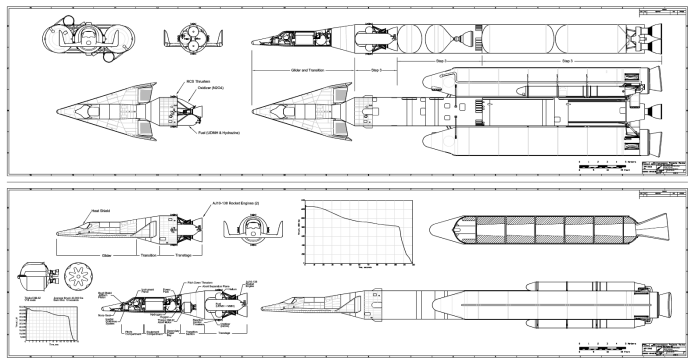
7: XB-70, one sheet, 1/144 scale
8: ITHACUS troop transport, two sheets, 1/200 scale
